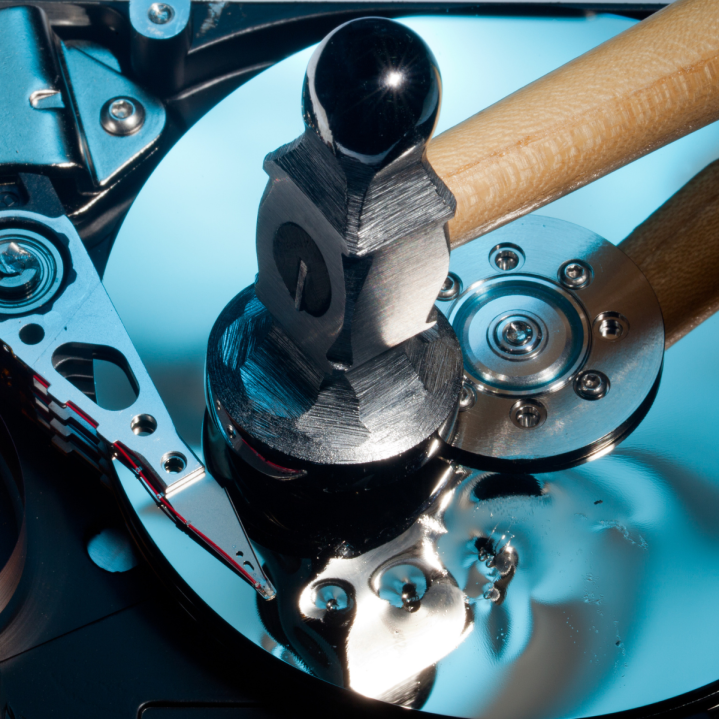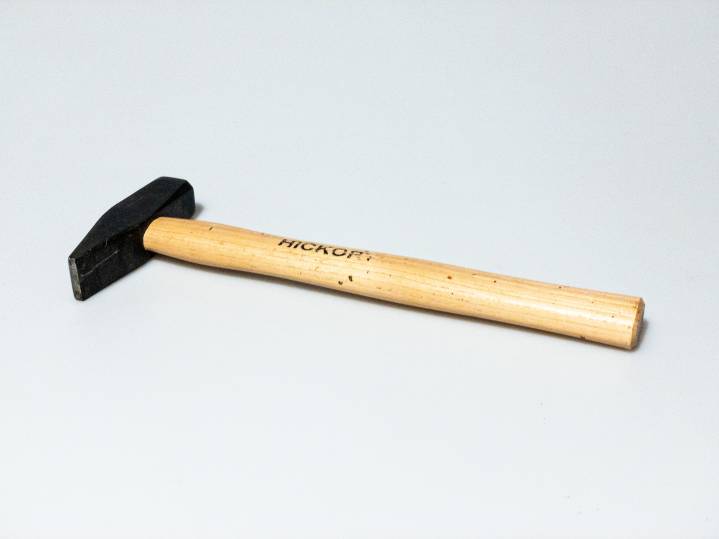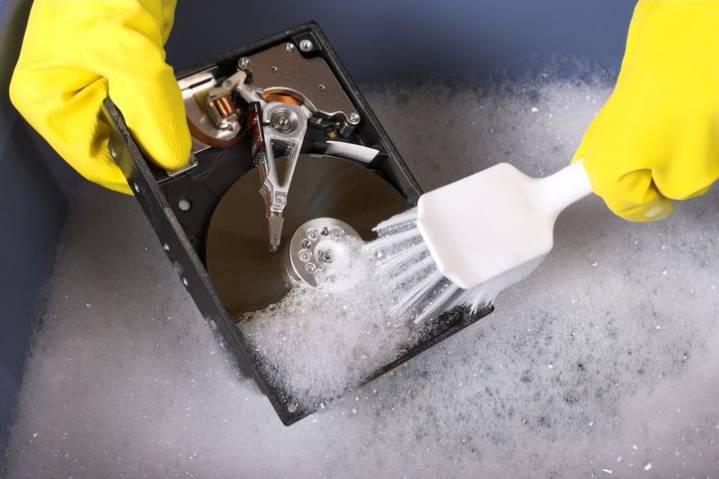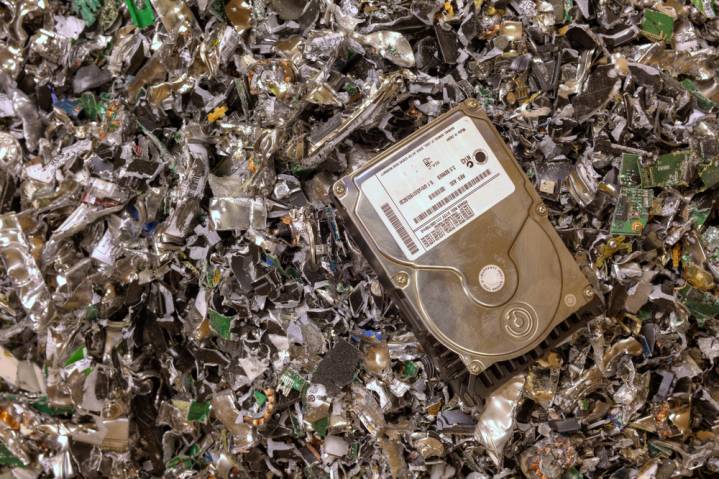


Is destroying a hard drive enough to permanently remove data?

The quick answer to this question is “no”. The practice of physically destroying hard drives has been a common method of removing data for many years, but it's not the best solution for multiple reasons.
We understand why choosing to destroy your hard drive is a tempting response to the issue of data removal. It can provide an accessible and DIY solution to the problem, as well as a sense of finality and satisfaction that you simply don’t get by using software. But in addition to being bad for the environment, physical destruction doesn’t offer peace-of-mind that your data is unrecoverable.
In this blog, we will take a look at 3 of the most common options of hard drive destruction and outline what stops them from being secure. Finally, we'll offer you an alternative solution that is more effective, ethical and eco-friendly.
You’ll find no shortage of ways to potentially destroy your hard drive on the internet. Here, we point out the flaws in 3 of the most typical destruction methods: hammers, water and shredders.

The most typical method of hard drive destruction involves the trusty hammer. I mean, we all have one, so it couldn’t cost anything to try out this approach. By sufficiently whacking your storage device, the assumption is that no data could ever be retrieved from the wreckage that remains. But this assumption is a bit hasty.
Firstly, destroying the external electronics and circuit board is not enough to render data unrecoverable. If the internal platters remain intact, then it’s relatively simple to restore the drive by retrieving data with a special reader. But even if you’re more successful with your efforts and you manage to shatter the hard drive, it’s still possible to read the shattered drive by reassembling the disk. While this is a difficult task, there’s simply no need to allow the prospect of data recovery to exist.
Summary
👍 Pros
👎 Cons
"Within a hard drive, there are several square feet of [read/write] surface,
and any given file takes up less than a square millimeter.
That means even if the drive is dented or shattered into tiny pieces,
the actual surface that contains the data is still there and readable."
– Dan Kaminsky, Computer Security Researcher 1

Plunging a laptop or computer into water is another method of data destruction that’s not as effective as you might think. Although water will cause electronics to short circuit, it’s unlikely to do much more than that. The reason? Magnetically stored data remains on platters, regardless of whether they get wet or not. So, providing platters don’t dry out, forensic experts should be able to recover data from drowned hard drives with relative ease.
The biggest plus of this approach is that it’s free, but soaking your laptops in water is certainly not eco-friendly and it won’t offer peace-of-mind that your data has disappeared for good.
Summary
👍 Pros
👎 Cons
"Now a hard drive's chassis is actually built
with really good engineering specs.
These things are designed to endure
a lot of wear and tear from being dropped,
being emerged in water and so forth.
That even if these things occurred to it
and it damages the chassis ...
the data on the drive is almost
100 percent recoverable."
– Rob Lee, Forensics Expert & Educator, SANS Institute 2

Shredding hard drives into hundreds (or even thousands) of pieces is one of the most common methods of data destruction. This solution works by using a large and expensive machine to shred hard drives into a great number of 4mm, 3mm or 2mm pieces. The National Security Agency recommends that hard disk drives are disintegrated into “particles that are nominally 2-millimeter edge length in size”. Most industrial shredders, however, produce fragments that are much larger.
In addition to being an environmentally harmful option, shredding is a flawed method of data removal as it doesn’t result in the complete destruction of hard drives. Instead, by leaving behind shredded pieces, it opens the door for data to be recovered with the use of microscopes. Although it’s very unlikely that a hard drive’s entire database could ever be rebuilt, a single 2mm shred holds approximately 22.49 GB of information that is fairly easily retrievable.
Summary
👍 Pros
👎 Cons
"The forensic techniques available today
are remarkably advanced, from recovering ghost images
to reading minuscule fragments of disk platters.
Any given file occupies less than .0015 square inch,
so even small fragments can be read
with advanced equipment."
– John Gunn, Vice President, VASCO Data Security 3
As you can see from the examples above, physically destroying hard drives is not a particularly secure method of data removal. In each case, what appears as a permanent solution ultimately leaves the door open for your data to be recovered.
If you insist on smashing your hard drive, the most secure approach is to wipe it first. In truth, there’s simply no need for you to resort to physical destruction though.
Not only is wiping your hard drive enough, it’s the most secure option available. When we talk about data wiping, we’re referring to the process of using software to permanently remove the contents of a file or disk space by overwriting data with 0s and 1s. One type of software that can be used is BCWipe Total WipeOut, which has been certified by the ADISA Product Claims Test to erase information beyond forensic recovery.
Key benefits of data wiping:
In addition to the above general benefits, trusted software like BCWipe Total WipeOut also enables organizations to:
Now you know why destroying hard drives isn’t enough to permanently remove data, find out how to securely wipe your computer clean and review our 5-step checklist for hardware decommissioning.
For a free consultancy get in touch with one of our Data Protection Specialists.
¹ Popular Mechanics, How To Read A Smashed Hard Drive [Online], Available: https://www.popularmechanics.com/technology/security/how-to/a8566/how-to-read-a-smashed-hard-drive-14877558/ [23 Nov 2022].
2 BankInfoSecurity, Forensics: When is Data Truly Lost? [Online], Available: https://www.bankinfosecurity.com/forensics-when-data-truly-lost-a-5380 [23 Nov 2022].
3 USA TODAY TECH, Destroying Information on a Hard Drive Isn't Easy [Online], Available: https://eu.usatoday.com/story/tech/2015/12/04/destroying-information-hard-drive-isnt-easy/76785790/ [23 Nov 2022].
Related Articles
Does Degaussing Work on SSD?
Data Sanitization 5 Common Myths
Hardware Decommissioning Process: A 5-Step Checklist
How to Securely Wipe Your Windows 11 Computer Clean
How to Wipe a Hard Drive on a Dead Computer
How to Wipe an NVMe Drive
How to Wipe an SSD on Windows 11 & 10

Jetico Technical Support helps customers find answers...
- Access our knowledge base articles
- Watch our How-To videos
- Contact us for insights
